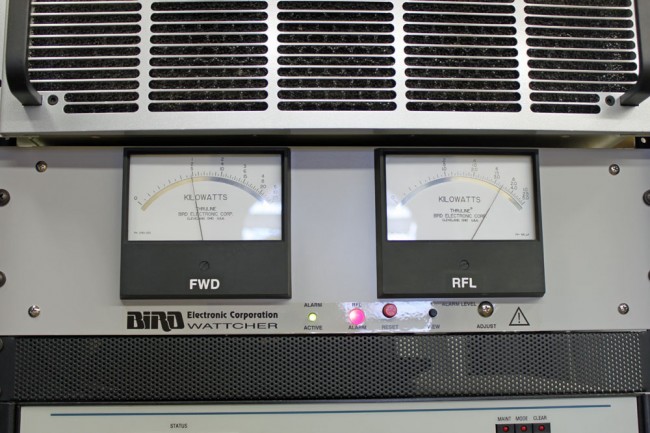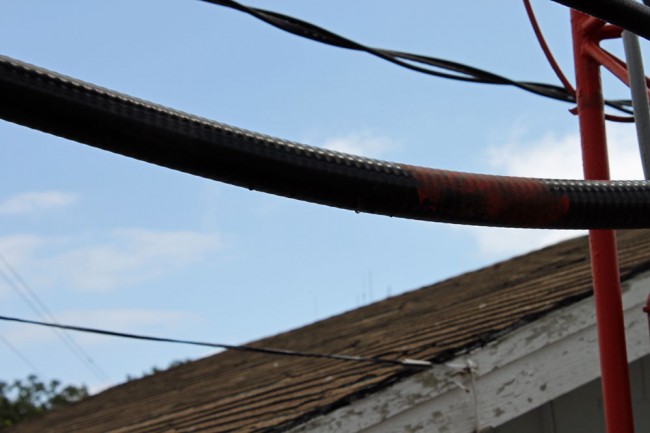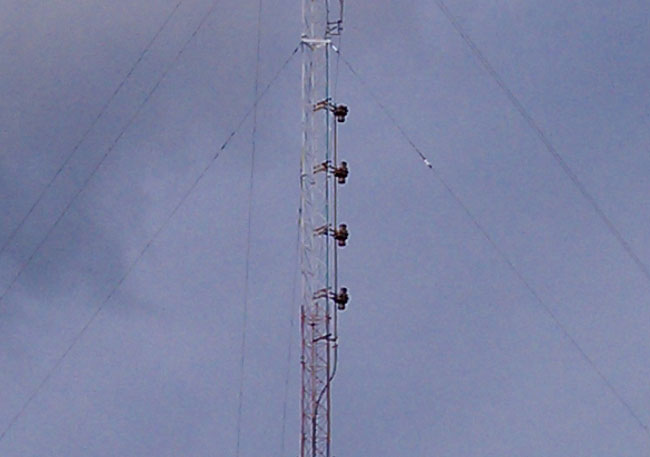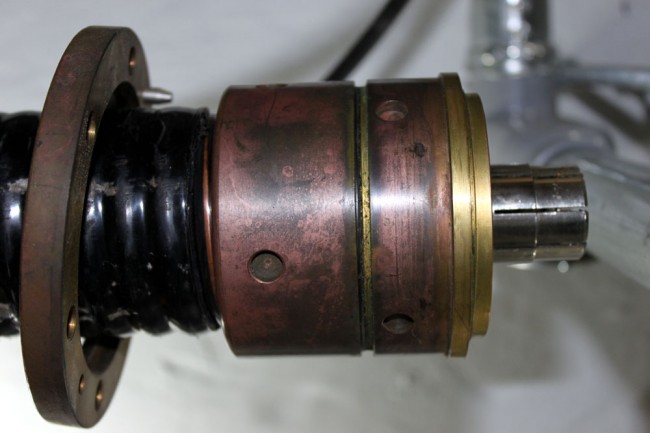Last year, the main antenna and transmission line for WSPK was replaced. I was, therefore, somewhat surprised to hear that there was an issue with the new transmission line. And yet, problems there are. Most likely, some ne’er do well has shot the transmission line with a bullet making a hole, which, when it rains, allows in water. Said water then accumulates in the bend at the bottom of the tower. When enough water is present to fill the gap between the center conductor and the outer conductor, this happens:

For those of you keeping score at home, that’s 980 watts forward, 375 watts reflected or about 4:1 VSWR. Obviously not a good load, in fact the transmitter shut down. Fortunately, the backup transmitter and antenna system worked flawlessly.
This began happening last month, usually after a heavy rain storm. Thus, I went out to the base of the tower and shook the transmission line and sure enough, water was sloshing around in there. Last time time it happened, a tower crew was summoned to inspect the line. Inspect it they did, but did they find any holes? No, they did not. Perhaps the issue is with the antenna itself, in which case the entire thing will have to be removed from the tower and lowered to the ground. In the mean time, my boss drilled a small “weep hole” at the bottom of the bend where the line comes off the tower.
I uncovered this weep hole and pressurized the line and viola, lots of water came out:

A bit unconventional, but effective nonetheless. The first video is of the water dripping out:
The second video is of me walking back into the transmitter building to pressurize the line:
Everything is very noisy because it is Monday, when all the generators on site exercise. There are five diesel generators running while I was videoing recording this.
I would estimate about 6 ounces of water came out through the weep hole, most of it landing on the ladder underneath. After the water was drained out, the transmitter came back on at full power and normal VSWR.
A temporary fix to get the station back on the air. The real repair work will begin when the antenna comes down to be inspected.
Update: The tower climbers did find a hole in the transmission line, just below the flange that connects to the antenna. It looks like a pencil sized gash just before the line bends back to the tower. Lightning? Rifle bullet? Damage while installing? We can’t really tell. They installed a patch over the hole which holds about 3 psi line pressure. We then used a vacuum pump to evacuate the line, then recharged with dry nitrogen.
Regarding Pedro’s question below in the comments: Since we found this problem quickly and were able to evacuate the line, there should not be any corrosion, that is our hope. Time will tell






Would it be possible to plug the hole you made, and apply 10-15 psi pressure, then have the tower guys climb on a quiet day, listening and feeling for leaks? That might be less expensive than pulling the antenna down as the first step. Also, if they can disconnect the coax and make the end air-tight, that might tell you if it’s the coax or the antenna.
Any way to inject some sort of smoke or powder into the line? If it was escaping, it might leave a visible trail. Or perhaps some odiferous compound, like the stink they put into natural gas. This way the tower guys can literally sniff their way to the leak.
Just trying to divide and conquer.
Bob M.
Bob, Last time the tower crew was here, they checked the entire length of the transmission line and found no holes. I thought about disconnecting the antenna, applying a gas block connector to the end and trying to pressurize the line, which we will do before we lower the antenna. Still, I am not optimistic that the problem is not in the antenna. I think those big red RADOMS make a good target for somebody on the ground.
Hello !
Once you got so many water inside the coax isn’t it going to oxidize and need to be replaced ?
How long can it work before corrosion makes it less conductive than it should ?
Is there a way to “clean” the inside of the coax to reduce the moist and prevent corrosion ?
Thanks in advanced.
Keep up the good work, I’ve learned some things about broadcasting here.
Best Regards
Pedro
Hi Pedro, after we found the hole in the upper part of the transmission line, we patched both. We evacuated the line with a vacuum pump for several hours, then refilled with dry nitrogen. Hopefully this will prevent any oxidization, but time will tell.
Hi!
My base station is having the same problem with the 5 Inch, 150 meter feeder . Removed 01 feeder head for water to flow out, but still not able to remove moisture inside. now the reflected power is increasing steadily.
I am implementing the solution of pumping – discharging air in the feeder but the efficiency is not high. Is creating a hole for water to follow out a safe solution?
Looking for advice from experts to handle the problem effectively.
Hi Nguyen,
Is there a safety relief at the far end of the line? Sometimes you can slighly overpressure the line and open it up forcing dry air through to evaporate the water. I would not attempt this if you are unsure a safety release exists or not.
A vacuum pump works great, basically it lowers the vapor point in the line so that all of the water evaporates. Many times HVAC companies will have vacuum pumps that perhaps you can borrow or rent.
Creating a very small hole is the last and least desirable option. It should be at a low point in the line and somewhere that can be patched effectively once all the water has drained out.
You should also determine how the water got into the line in the first place.
I prefer a vacuum pump to remove water from waveguide and satellite dish feed horns. In some cases it took as much as four days of running the pump to remove all the water. This was after trying to remove the water with dry air or nitrogen, even with multiple purges. The pump came from Granger for less than $300. The water contaminated the oil, so the oil needed changing after every use of the pump.